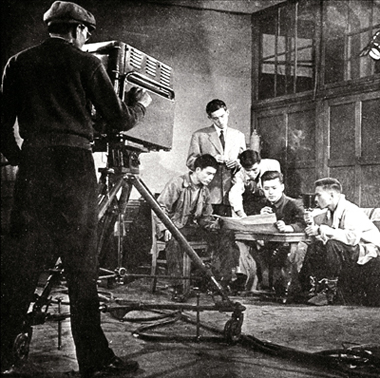 |
|
"Red Flame," the first TV series broadcast by Shanghai Television Station.
|
Xu Nuo, the retired 74-year-old former director of Shanghai Television Station, still clearly remembers how she and her team handled the debut broadcast at the TV station on October 1, 1958.
Xu recalls how her trembling fingers pressed a button at exactly 7pm and a round clock became the first image broadcast live on television to viewers across Shanghai. The top news that followed was the National Day parade and celebration in Beijing.
The moment also marked the official launch of the Shanghai television industry, following the industry's inception in Beijing on May 1 the same year.
"I was nervous yet excited to take on the task," Xu says. "We received one month of training at the newly established Beijing Television Station (the former name of China Central Television). Before that, we knew almost nothing about TV broadcasting."
Zhu Dun and Zou Zhimin, the first Shanghai TV reporters to deliver news to local audience, were also proud to be involved in the landmark event 50 years ago.
"The cameras were borrowed from the August First Film Studio and a thrift shop," Zhu says. "After filming the scenes at People's Square, we realized we didn't have film developing technicians. So we resorted to an X-ray unit at a local hospital and made our first TV news there."
When the Shanghai Television Station was first established in 1958, it consisted of just one channel, broadcasting twice a week.
The TV studio was located in a 60-square-meter room on the 13th floor of the Yong'an Building on Nanjing Road. Without a news van or broadcast vehicles, reporters and television cameramen usually carried their heavy cameras on their own with the help of a trike or even bamboo poles.
By the 1970s, after more than a decade of development, Shanghai boasted three television channels, although TV sets were still a luxury for many people.
"When I bought a nine-inch black-and-white TV about 30 years ago, my home was flooded with curious neighbors," says Xu Ziyan, a 62-year-old retired teacher. "Later we saw the arrival of color televisions. Yet it still took a few years for them to spread to the majority of Chinese households."
Xu recalls that programs in the early years were rather dull. Aside from news and sports programs, there were so few choices for entertainment-hungry audience they would often remain glued to the TV just to watch the end credits of programs.
A remarkable change to the TV industry came at the January of 1979, when China's first television advertising slot was sold. The 90-second commercial about a domestic ginseng wine was aired twice a day attracting big crowds of customers.
One month later, a commercial for Rado watches was also broadcast and was so popular, hundreds of local people swarmed to department stores to buy the watch.
Since then, the domestic TV industry has gradually transformed from being state-subsidized to self-subsidized.
Many TV stations, facing a constant struggle to survive, started to open their minds, adjusting their goals to attracting as many viewers as possible by placing a high premium on satisfying the audience's needs.
A lot of popular programs were produced in the 1980s-90s such as CCTV's annual Lunar New Year Gala, STV's "Casio Family Singing Contest" and quiz show "Intelligence Surfing."
In the late 1990s, when many provincial TV channels gained access to satellite transmission, people saw even more opportunities for the industry.
In 2001, Shanghai Media Group was established based on Shanghai People's Broadcasting Station, Shanghai Orient Broadcasting Station, Shanghai TV Station, Orient TV Station and Shanghai Cable TV Station with a total staff of more than 5,000.